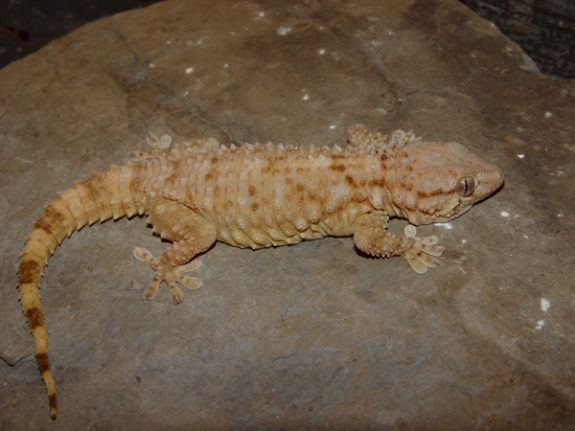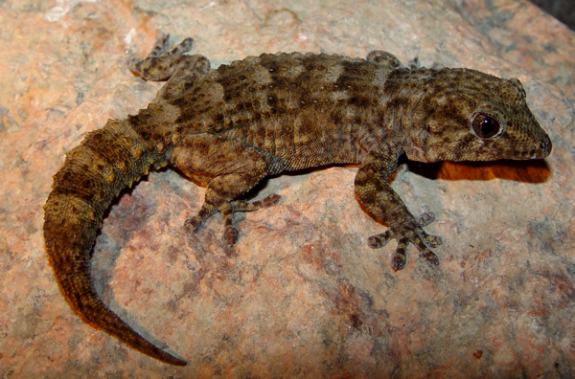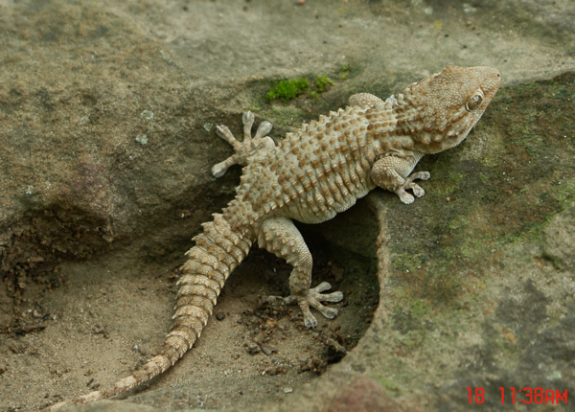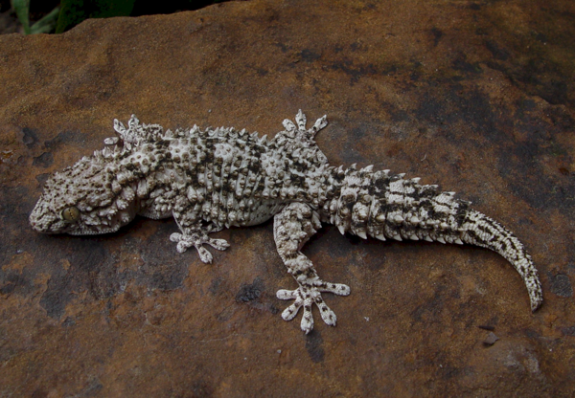Tarentola is a genus of gecko with a wide ranging distribution. The most common member of this genus in captivity is the T. chazaliae, commonly called the “helmeted gecko”. These are small, relatively undemanding geckos and hopefully the information about them below from three keepers will inspire others to look into getting some. In addition, as a special treat, one contributor provides very interesting information about how these geckos figure into Saharan folklore.
As usual, our 3 expert keepers have responded to the following questions:
- Which species are you keeping?
- What got you interested in this (these) species and where did you get your first one(s)?
- How are they set up? Describe your enclosure.
- What do you find most interesting about them?
- What do you find to be the biggest challenge?
Mikko Ilosalo
I keep Tarentola chazaliae, currently only one female, though I have kept more in the past.
I ran into pictures of them on GeckosUnlimited back in 2012, and got really interested and ran into an ad selling them at a show in Germany. After a small chat we set up a meeting between the vendor and my friend who then brought a pair to me to Finland.
My enclosure has varied a lot, and is changed up constantly. It’s sized 45x45x45cm (18″x18″x18″) and lighted with a 35W Solar raptor Flood. I try to give some areas to climb on, but not going too high or “demanding” as they aren’t particularly good at challenging surfaces. I’ve used substrates such as clay, sand, coco husk and paper, and different ratios of the first 3. All the substrates have worked out fine. Currently she’s on paper before aiming for a new attempt at a desert planted terrarium.

What I find most interesting is their extremely aggressive feeding behaviour and extremely courageus behaviour when they’re approached. Shy is the extreme opposite of the word to describe the individuals I’ve kept. Even the just-hatched youngsters ate off my fingers 5 minutes after crawling out of the egg.
The biggest challenge for me ended up being the extremely aggressive mating behaviour, which resulted in the death of the male. (the female bit the male’s hemipenis to be specific, resulting in an infection that took its toll after few days). Other then that even though the species has a bad reputation of being at times hard to keep, for reasons such as hatchling deaths early on or problems caused by diet, I haven’t run into these problems personally.
Jon Boone
I’m currently keeping Tarentola: annularis, angustamentalis, boettgeri, delalandii, ephippiata and nicolauensis. In the past I’ve also kept bischoffi, boehmei, (Geckonia) chazaliae, deserti, gomerensis, mauritanica, mindiae and rudis.
I purchased my first Tarentola (mauritanica) in 1984 from a West Coast dealer and quickly learned that members of this genus are stout and durable animals – as they thrived during my college years – when I was frequently more preoccupied with other, non-reptilian, hobbies. Soon thereafter I purchased Tarentola annularis almost immediately after reading Arthur Loveridge’s account in his book “African Gekkonidae” (1947. Page 328-329), and I’m not aware of any other gecko that is surrounded by more folklore than T. annularis – some of which I would like to share here:
“If a gecko is seen near a vessel containing milk or water the liquid will be thrown away for not only its breath but a look at the fluid is sufficient to render it unfit for human consumption. It is believed that after drinking from such a vessel the gecko habitually spits into it and the spittle is believed to be very poisonous. A person drinking from such a contaminated vessel will at least suffer stomach pains if they do not actually die. A water jar, if left uncovered overnight is liable to be visited by a “dab”, as this gecko is called at Khartoum. After taking its first drink the gecko is said to vomit into the bowl before drinking again. To frighten a gecko from such a vessel it is only necessary to lay a knife across the top!
Similarly if a watermelon is cut into and a portion set aside for tomorrow, it is usual to leave a knife sticking into it to prevent a gecko from partaking of, then spitting on, the fruit. The gecko is accredited with being the “guardian” of melon seeds according to a Berber native.
Salt should be protected or the gecko will urinate upon it, thereafter anyone eating such contaminated salt will break out in a rash of brown and black spots like those on the gecko’s back. When blister beetles caused an outbreak of blisters on the necks of soldiers in the Khartoum garrison, the men averred that the blisters were caused by the lizards on the ceiling urinating upon them.
If the feet of a gecko running over a person should touch the eyes, the latter will become inflamed; on the other hand if it is the skin that is involved the latter will blister and burn – alternatively leprosy will result. Should a pregnant woman so much as set eyes on a “dab”, her baby, when born, will be disfigured with spots like those to be seen on the gecko“.

A few years later, in 1993, I spent 6 weeks on the opposite side of Saharan North Africa (Morocco) in a quest to find Tarentola (Geckonia) chazaliae in its natural range, along with some of the other Tarentola that occur through the western mountain ranges of the Saharan desert. While camping with Berber shepherds in the Sahara one of the natives dramatically explained to me, while sipping hot mint tea in a camel-hide tent at night, that T. chazaliae was, in fact, referred to by local people as the “green mother of snake”. His story recounted the arrival of mankind to this planet and how many thousands of years ago man was tempted and beaten by a great serpent, and that the T. chazaliae, with its fierce looking helmeted head, challenged and beat the serpent, but in the process of doing so – was disfigured from the battle impact with a helmeted head, and reduced to living on the desert floor (where the snake lives and was driven from). The shepherd concluded that the gecko was a protector of man, and while he would show me the actual spots to find them, he kindly requested that we respect the gecko and take great care in finding and releasing them. Along the 3-4 foot high earthen walls that completely encompassed the desert compound where I slept, many Tarentola boehmei were found at night. When asked about these the shepherd told me that these geckos were welcomed as they were regarded as being useful in insect control by reducing flies, mosquitoes and other insects that abounded in the desert oasis.
The habitat of T. chazaliae varies greatly moving from the Atlantic coast inwards into the initial Saharan sand dune fields. Along the coast, we found numerous T. chazaliae within a stone’s throw distance of the ocean where a peculiar, man-influenced anomaly produces great habitat for them: the commercial practice of stores and local shops to hand over purchased items in a black plastic grocery sack. At that time, sadly, people would just discard their bags into air and they would eventually lodge into the landscape as they came to rest on moist/wet ground, along the perimeter of bushes, etc. These plastic bags, now tethered to the ground, served as small solar panels for the wandering and perhaps cold Geckonia, as the wind coming off of the ocean current was sharply cold. By pulling the small bags from the sand, we found T. chazaliae much easier and more comfortable to locate than by following the written and understood practice of “flipping camel dung splats”. The coastal form of T. chazaliae were smaller and quite common, whereas inland forms living in the valleys between mountains were substantially larger – perhaps 150-200% larger in overall mass.
Needless to say, experiencing that personal event “sealed the deal” for me and my interest for this genus.

Arboreal species are simply set up in dry and rock terrariums that are more vertically oriented, and with a sand substrate. A typical enclosure for the smaller bodied forms (ex. nicolauensis, boettgeri and delalandii) are approximately 12 inches cubed, and with front opening doors. The other larger forms are kept in terrariums that are 12 x 14 x 18 inches high. Rocks are situated at the rear of the terrarium to promote greater safety (for keeper and kept) and a natural flight path away from the door while feeding and servicing their enclosures. Substrate of 1-2 inches of fine-medium sand is sufficient, and the gravid females will deposit eggs generally in the corners, or at the base of rock fixtures, and then cover them with a liberal mound of sand.
T. chazaliae – are best kept in terrariums that measure about 15 x 15 x 8 inches high with a few ground hides and with natural lighting. They also tend to do better if exposed, periodically, to UV lighting during the cooler months, as they will occasionally bask if their thermal optimums are provided by lighting. This may help promote a more successful breeding season as the temps begin to rise into the spring.
I find the history, folklore, pugnacious behavior and adaptability of Tarentola species to be particularly interesting – as very few gecko genera display this rich combination of attributes. They not only possess a “classic gecko look” but this genus contains a broad diversity of species that are distributed across the Mediterranean area, and then, almost mysteriously, a few species (some fossil) in the Caribbean (ex. albertschwartzi, crombiei and americana).
Some keepers might find the breeding of Mediterranean forms challenging, as the tendency is for some specimens and types to breed only once every two years. However, once they adapt to captivity, they generally follow suit and produce every year. Otherwise, my collective experience across many members of this genus suggests that they all make very durable and undemanding captives which might well rank as having the most unbelievable of folklore roots, and also form a very integral part of the day-to-day lives of the various societies living in the Sahara.

Amber Walker
I keep helmeted geckos also known as tarentola chazaliae.
I became interested in helmeted geckos after doing some research on geckos. I was looking for a species to keep. I was interested in terrestrial geckos and had looked into bearded dragons, but decided against them because of their large size. During my research I came across some information on helmeted geckos. Their grumpy faces and chunky bodies instantly took me in. I also liked their small size. I wanted a species that I could keep that would not end up taking up my entire house (since we have limited space). They were the perfect size. I obtained my first male through Switzer reptiles and happened upon a female in a pet store’s online website. Females are especially hard to find so I was very lucky.
I have mine set up in a 20 gallon tank. I have an under tank heater for the warm side. During the day I have a UV daylight bulb and during the night I have a red night bulb. They are housed on sand. Since they love to hide I have several pieces of wood to create crevices for them and two moist hides.
The croaking noises that they make back and forth between each other are so entertaining. They also wag their tails back and forth.
I find the biggest challenge is the first shed for the babies. Sometimes they shed perfectly and other times they have a difficult time. In general the babies are the biggest challenge. They are a bit finicky.

Jon Boone has kept and bred approximately 550 different species of geckos since 1981. He has also had the fortunate opportunity of finding approximately 150 different species in nature from more than 25 different countries around the world. Combining field experiences with a captive collection provides him with what he feels are unique perspectives into the lives of the animals that we all keep and study. Jon might also be one of the only gecko people in the world to have been featured in a People magazine article. His website www.jonboone.com also provides the collective community of zoologists, researchers and hobbyists with a vast number of photos from live geckos he has kept and bred over the years.
Mikko Ilosalo: I’ve lived my entire life in Finland, in a town called Rauma. Ever since I was a child I have been fascinated with nature, from birds to fish and eventually reptiles. I work at a paper factory in town and much of my spare time is dedicated to reptiles, be it researching or just generally taking care of my own. At the very early stages of my entrance in to the hobby, I learned that Finland is massively behind in terms of understanding reptiles. This forced me to reach outside of the country for information and this also made things move more slowly than I would have hoped. In the future I am hoping to get properly into breeding reptiles and improving myself in terms of understanding reptiles constantly.
Amber Walker is a teacher residing in Tennessee. She has had a love of all animals from the time she was little. Early on she was interested in keeping and breeding fish, but gave up that idea because you can’t hold fish. She received her first reptile as a teenager in the year 2000. This love grew as she aged and she finally became seriously interested in keeping geckos as a hobby. This blossomed into many many cages and a growing collection.


Very informative and interesting article. These are some beautiful geckos. Go to our site, GeckoTalk.com to see more gecko photos and to discuss gecko husbandry with others.
Very interesting; Time to go find myself a Helmeted Gecko!